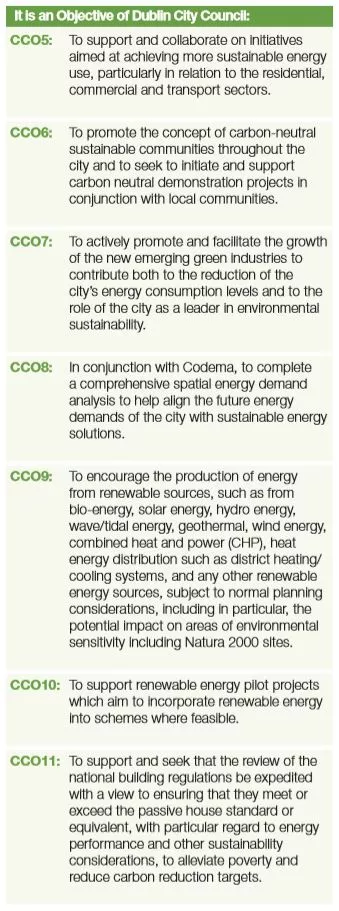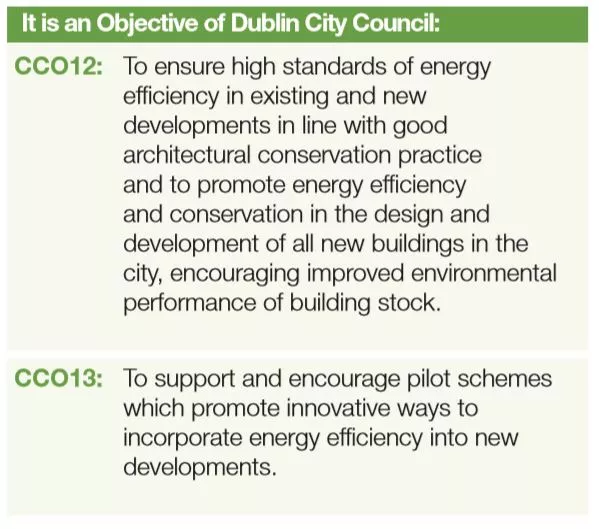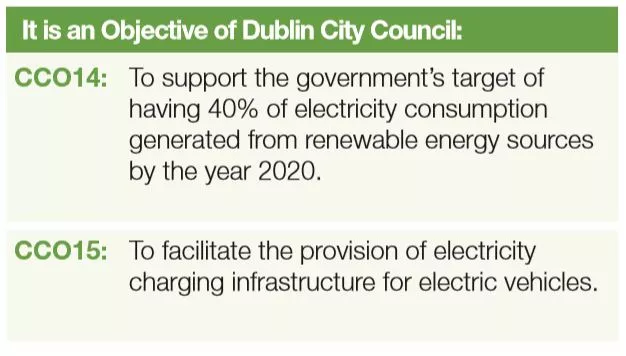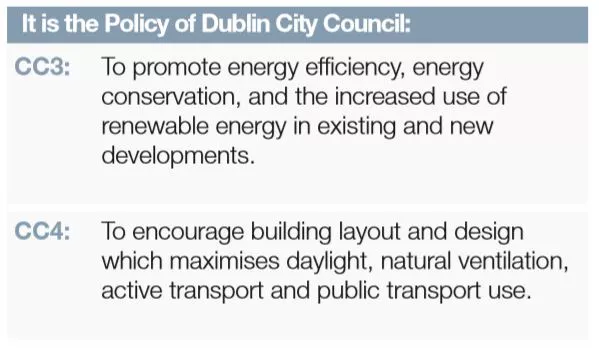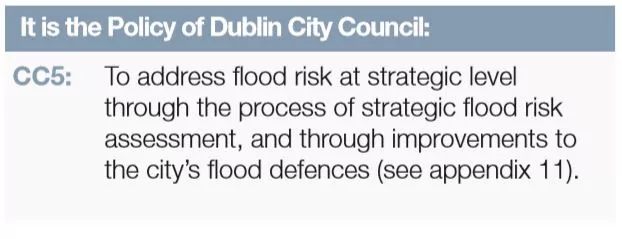3.5.2 Sustainable Energy/Renewable Energy
3.5.2 Sustainable Energy/Renewable Energy
Dublin City Council is committed to pursuing sustainable energy policies in accordance with the White Paper ‘Towards a Sustainable Energy Future for Ireland 2007 – 2020’ and ‘Ireland’s Transition to a Low Carbon Energy Future 2015 – 2030’. Fossil fuel use is responsible for over half of all GHG emissions globally, and the majority of these emissions come from energy supply, transport, residential and commercial buildings, and industry (IPCC, 2007).
Reducing energy consumption and finding alternative, non-polluting, and renewable sources for energy provision and transport are the more prominent issues targeted by national and international policies in order to reduce CO2 contributions.
The national level ‘Strategy for Renewable Energy 2012 – 2020 (Dept of Communications, Climate Action and Environment) seeks a 20% improvement in energy efficiency by 2020, along with 20% of energy to come from renewable sources and a 20% reduction in EU CHGs.
In 2014, the EU Commission published its Climate Change and Energy Framework 2030, which seeks to make progress to achieve a low carbon economy. It proposes to achieve a 40% reduction in greenhouses gases by 2030 relative to 1990. The two main EU Directives which aim to meet these targets are the EU Energy Efficiency (EE) Directive (2012/27/EU) and the EU Renewable Energy Sources (RES) Directive (2009/28/ EC).
Under the RES Directive, the target set for Ireland is for 16% of national gross final energy consumption to come from RES by 2020. On foot of this, the National Energy Action Plan (NREAP) outlines how the 16% target can be achieved, and sets national sectoral targets. The National Energy Efficiency Plan (NEEAP) sets out a policy road map to 2020 setting a higher target of 33% energy reductions in the public sector. Also of relevance are the Irish Building Regulations 2011, Part L of which aims to incorporate high levels of energy efficiency and RES in new dwellings.
Renewable Energy Sources
Renewable energy comes from natural sources that are continuously replenished by nature and is, therefore, a more sustainable alternative to our dependency on fossil fuels. The main sources are wind energy, solar energy, water energy (hydro, wave and tidal energy), geothermal energy (from heat below the surface of the earth) and biomass (wood, biodegradable waste and energy crops).
The Dublin Waste to Energy Project is a public private partnership (PPP) between Dublin City Council (acting on behalf of the four Dublin local authorities) and Covanta, to provide a thermal treatment plant to treat municipal waste that cannot be reused or re-cycled. Located in Poolbeg, the plant will generate energy from up to 600,000 tonnes of waste per year that would otherwise go to the landfill, and will generate enough electricity for up to 80,000 homes annually. Operations are expected to commence by 2017.
Dublin City Spatial Energy Demand Analysis (SEDA)
The purpose of SEDA is to enable a greater understanding of the current and future energy demand and local energy resources of Dublin city within a spatial context. A methodology has been developed by Codema which allows estimations of energy demands in each building in the city in the residential and commercial sectors which will be mapped along with real energy data for municipal sector buildings.
This mapping process provides a visualisation of areas of high energy consumption, high fossil-fuel use, high heat demand density and approximate associated energy costs across the city. From this information, ‘energy character areas’ can be defined, that is, areas with distinct types of energy needs, consumption patterns and fuel types used, and these needs can then be matched to the best available technical solution which incorporates renewable resources and energy-efficient solutions. In particular, this mapping allows areas of high heat demand density (over 150 TJ/km2) to be classified as suitable for large-scale district heating schemes. The spatial energy demand analysis was completed in June 2015.
Energy Efficiency and the Built Environment
The encouragement of energy efficiency in the built environment relates not only to the building code and individual buildings, but also to the design and layout of schemes by maximising benefits from natural ventilation and lighting and also by encouraging walking/cycling for residents/occupants and reduced reliance on fossil fuels. Also, because the range and design of buildings within the city varies enormously, innovative ways to improve energy efficiency within them are encouraged.
Electricity
The demand for electricity in the east region is expected to increase by over 80% by 2025. ESB Networks is the key provider of electricity infrastructure in Ireland and works closely with Eirgrid, which is responsible for the operation and the development of the transmission system. Eirgrid’s grid development strategy, GRID25, is designed to ensure that the transmission network has the capacity to provide for growth in electricity demand between now and 2025 (although it is noted that this strategy is being updated and will be replaced by a new grid/transmission strategy plan).
There are existing large-scale thermal generating stations at Poolbeg, North Wall, Huntstown and Irishtown and a pumped storage facility at Turlough Hill in Wicklow. Wind resources are confined mainly to offshore locations. Eirgrid and the ESB have a range of major electrical infrastructure projects planned for the coming years.
Electric vehicles and e-bikes
Electric vehicles (EV) refer to both battery electric vehicles (BEV) and plug-in hybrid vehicles (PHEV) together with e-bikes. Ireland’s target is to achieve 10% electric vehicle usage by 2020. The ESB has installed a number of charge points around the city for electric cars, and transport policy in this development plan (see Chapter 8) promotes the further expansion of such charging points.
